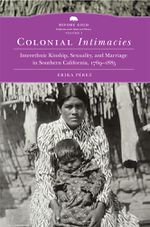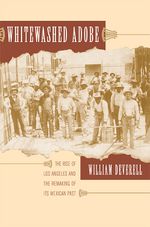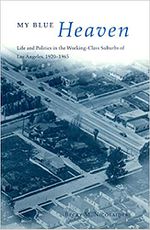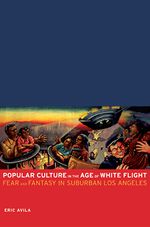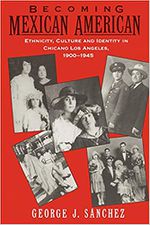Difference between revisions of "Top Ten Books on Los Angeles History"
| Line 1: | Line 1: | ||
| − | [[File: | + | [[File:9780520249905.jpg|300px|thumb|left|''Bound for Freedom: Black Los Angeles in Jim Crow America'']] |
Los Angeles has emerged from a small pueblo in the Spanish colonial backwater to become one of the most recognizable and populous cities in the United States. Los Angeles is an idea, the butt of many jokes, and a topic of serious academic inquiry. Historians have studied Los Angeles for over a century. In terms of historical scholarship, Los Angeles sits at an interesting spot. It's history can be explored from Indigenous, Spanish, and American points of view, it can be on a colonial or modern reading list, regionally it is the Spanish north, American West, and Pacific Rim. When looking at race relations in Los Angeles, we see a diversity that is characteristic of the American west, and contrary to the racial dichotomy in the American South. | Los Angeles has emerged from a small pueblo in the Spanish colonial backwater to become one of the most recognizable and populous cities in the United States. Los Angeles is an idea, the butt of many jokes, and a topic of serious academic inquiry. Historians have studied Los Angeles for over a century. In terms of historical scholarship, Los Angeles sits at an interesting spot. It's history can be explored from Indigenous, Spanish, and American points of view, it can be on a colonial or modern reading list, regionally it is the Spanish north, American West, and Pacific Rim. When looking at race relations in Los Angeles, we see a diversity that is characteristic of the American west, and contrary to the racial dichotomy in the American South. | ||
| Line 7: | Line 7: | ||
| − | |||
Douglas Flamming, ''Bound for Freedom: Black Los Angeles in Jim Crow America'' (Berkeley: University of California Press, 2006). One of the most enduring myths about California is that African Americans did not experience as much racism or hostility there as in the South. In ''Bound for Freedom'' Flamming provides one of the most comprehensive studies of African American Los Angeles from the late 19th century to World War II. He illustrates that for most African Americans, when they came to Los Angeles, they came to a city that was half-free. Not as violent as the Jim Crow South, but just as racist. Ultimately, Flamming argues that the Civil Rights Movement of the 1950s and 1960s would have been unfeasible were it not for the work of African American activists in his study. This book is well-researched and quite thorough. If you're interested in African American history or the history of the Civil Rights Movement, you will likely enjoy this book. | Douglas Flamming, ''Bound for Freedom: Black Los Angeles in Jim Crow America'' (Berkeley: University of California Press, 2006). One of the most enduring myths about California is that African Americans did not experience as much racism or hostility there as in the South. In ''Bound for Freedom'' Flamming provides one of the most comprehensive studies of African American Los Angeles from the late 19th century to World War II. He illustrates that for most African Americans, when they came to Los Angeles, they came to a city that was half-free. Not as violent as the Jim Crow South, but just as racist. Ultimately, Flamming argues that the Civil Rights Movement of the 1950s and 1960s would have been unfeasible were it not for the work of African American activists in his study. This book is well-researched and quite thorough. If you're interested in African American history or the history of the Civil Rights Movement, you will likely enjoy this book. | ||
Revision as of 15:57, 20 September 2019
Los Angeles has emerged from a small pueblo in the Spanish colonial backwater to become one of the most recognizable and populous cities in the United States. Los Angeles is an idea, the butt of many jokes, and a topic of serious academic inquiry. Historians have studied Los Angeles for over a century. In terms of historical scholarship, Los Angeles sits at an interesting spot. It's history can be explored from Indigenous, Spanish, and American points of view, it can be on a colonial or modern reading list, regionally it is the Spanish north, American West, and Pacific Rim. When looking at race relations in Los Angeles, we see a diversity that is characteristic of the American west, and contrary to the racial dichotomy in the American South.
For those who are interested in studying the history of Los Angeles, these ten books below are a start. These ten books cover a variety of themes and topics that get at the heart of this unique place. In no particular order:
Carey McWilliams, Southern California: An Island on the Land (Layton: Gibbs Smith, Publisher, 1946). Carey McWilliams is easily his own subject of study when it comes to Los Angeles History. This journalist, editor, and lawyer is one of the most well known figures among Southern California historians and enthusiasts. McWilliams was a prolific writer and wrote extensively on Southern California. Southern California: An Island on the Land is widely regarded as one of the best works on Los Angeles in the 1920-1940s. It details many of the unique personalities in Los Angeles at the time, and also gives thoughtful consideration to minorities as well--unique considering this was first published in the 1940s. If you would like an overview of Los Angeles from someone who was there are the time, this book may be just what you're looking for. You may be frustrated by McWilliams' lack of footnotes, though.
Douglas Flamming, Bound for Freedom: Black Los Angeles in Jim Crow America (Berkeley: University of California Press, 2006). One of the most enduring myths about California is that African Americans did not experience as much racism or hostility there as in the South. In Bound for Freedom Flamming provides one of the most comprehensive studies of African American Los Angeles from the late 19th century to World War II. He illustrates that for most African Americans, when they came to Los Angeles, they came to a city that was half-free. Not as violent as the Jim Crow South, but just as racist. Ultimately, Flamming argues that the Civil Rights Movement of the 1950s and 1960s would have been unfeasible were it not for the work of African American activists in his study. This book is well-researched and quite thorough. If you're interested in African American history or the history of the Civil Rights Movement, you will likely enjoy this book.

